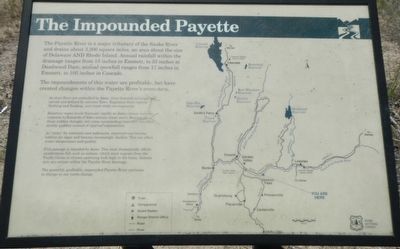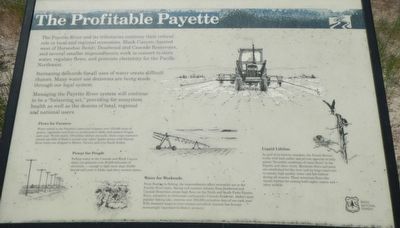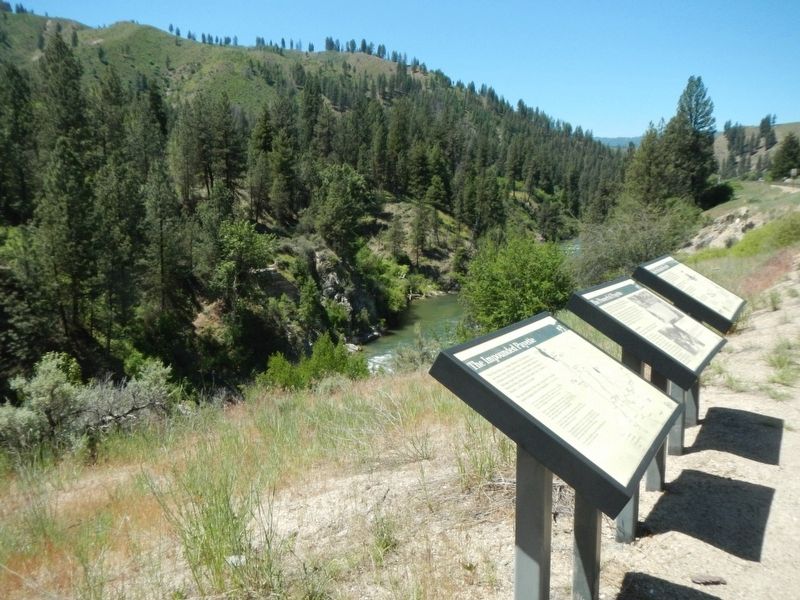Garden Valley in Boise County, Idaho — The American West (Mountains)
The Impounded Payette
Inscription.
(This marker consists of three panels:)
The Payette River is a major tributary of the Snake River and drains about 3,200 square miles, an area about the size of Delaware and Rhode Island. Annual rainfall within the drainage ranges from 13 inches in Emmett, to 33 inches at Deadwood Dam; annual snowfall ranges from 17 inches in Emmett, to 105 inches in Cascade.
The impoundments of this water are profitable, but have created changes within the Payette River's ecosystem.
As river flows are controlled by dams, river channels no longer are carved and defined by extreme flows. Regulated flows replace flushing and flooding, and create static environments.
Reservoir water levels fluctuate rapidly as dams release water in response to demands of downs-stream water users. Because of these sudden changes, wet areas surrounding reservoirs are often muddy puddles instead of riparian communities.
As 'sinks" for nutrients and sediments, reservoirs can become habitat for algae and become increasingly shallow. This can affect water temperature and quality.
Fish passage is impeded by dams. This most dramatically affects anadromous fish such as salmon, which must migrate from the Pacific Ocean to stream spawning beds high in the basin. Salmon now are extinct within the Payette River drainage.
The power, profitable, impounded Payette River continues to change as our needs change.
The concrete slabs you see below are the only remains of the Grimes Pass Dan. This dam generated electricity for Boise Basin gold dredges across the mountains to the south.
In 1862, George Grimes discovered gold in Boise Basin. As miners exhausted the easy-to-reach placers, they looked for other ways to extract the precious metal. Dredges enabled miners to reach placers deep in the streambed, but they required electricity. The first dredge in Boise Basin was built about 1898; dredges continued to operate in this area until the 1950s.
Bursting Dams
The first dam was constructed here in 1904. A year later, the earthen dam washed away during high water.
In 1907, dredge over W.H. Estabrook rebuilt the Grimes Pass Dam and added a power line to serve mines at Placerville, Centerville, Lightning, and Idaho City. Once again, the powerful Payette washed out the dam in 1943. Today, the South Fork Payette River flows free from its headwaters in the Sawtooth Mountains to its confluence with the North Fork near Banks.
Booming Towns
Boise Basin was the scene of one of Idaho's largest gold rushes. The population of Idaho City exploded to nearly 6,300, and
by 1865 the boomtown surpassed as the Pacific Northwest's largest city. By 1870, many miners has moved on to other fields in Idaho, Montana, and Nevada.
Mining has dwindled from it heyday in the 1800s. Today, recreational miners continue to search for gold in Boise Basin and along the South Fork Payette River.
The Payette River and its tributaries continue their critical role in local and regional economics. Black Canyon (located west of Horseshoe Bend), Deadwood and Cascade Reservoirs, and several smaller impoundments work in connection to store water, regulate flows, and generate electricity for the Pacific Northwest.
Increasing demands for all uses of water create difficult choices. Many water use decisions are being made through our legal system.
Managing the Payette River system will continue to be a "balancing act," providing for ecosystem health as well as the desires of local, regional and national users.
Flows for Farmers
Water stored in the Payette's reservoirs irrigate over 155,000 acres of grains, vegetables and fruits in southwest Idaho and eastern Oregon each year. Worth nearly 100 million dollars annually, these crops represent almost one-fifth of Idaho's overall crop value! Apples grown with Payette River water are shipped to Mexico, Taiwan and even Saudi Arabia.
Power for People
Falling water as the Cascade and Black Canyon dams can generate over 20,000 kilowatts of electric - enough to light more than 30,000 homes each year in Idaho and other western states.
Water for Weekends
From floating to fishing, the impoundments affect recreation use in the Payette River basin. Spring and summer releases from Deadwood and Cascade Reservoir created high flows on the North and South Forks Payette River, attractive to white water enthusiasts. Cascade Reservoir, Idaho's most popular fishing lake, receives over 350,000 recreation days of use each year! With dramatic leaps in river-related recreation, tourism has become increasingly important to Idaho's economy.
Liquid Lifeline
As part of its historic mandate, the Forest Service works with bot public and private agencies to help secure "favorable conditions of water flow" in the Payette and other rivers. Minimum flows and pools are established for the river and its large reservoirs to sustain high-quality water and fish habitat during all seasons. These minimum flows also ensure habitat for nesting bald eagles, osprey and other wildlife.
Erected by U.S. Forest Service, Boise National Forest.
Topics. This historical marker is listed in these topic lists: Natural Resources • Waterways & Vessels. A significant historical year for this entry is 1862.
Location. 44° 2.676′ N, 115° 51.21′ W. Marker is in Garden Valley, Idaho, in Boise County. Marker is on Banks Lowman Road (County Highway 17) near Annie Lane, on the left when traveling west. Touch for map. Marker is in this post office area: Garden Valley ID 83622, United States of America. Touch for directions.
Other nearby markers. At least 5 other markers are within 9 miles of this marker, measured as the crow flies. Snake Brigades & "Fur Deserts" (approx. 3.6 miles away); CCC Shapes the Payette Drainage (approx. 4.1 miles away); Henrietta Penrod Museum (approx. 8.4 miles away); Boise Basin Mercantile Museum (approx. 8.4 miles away); Fiddlers Murdered at Ophir Creek (approx. 8.6 miles away).
Credits. This page was last revised on August 24, 2020. It was originally submitted on June 26, 2018, by Barry Swackhamer of Brentwood, California. This page has been viewed 414 times since then and 28 times this year. Photos: 1, 2, 3, 4. submitted on June 26, 2018, by Barry Swackhamer of Brentwood, California.



